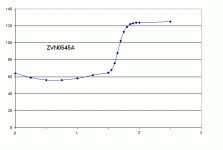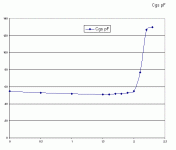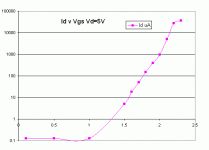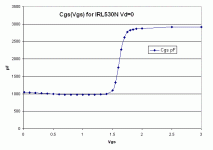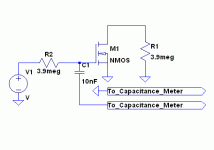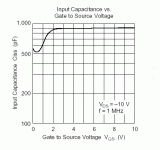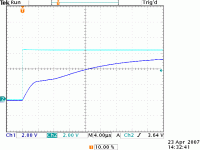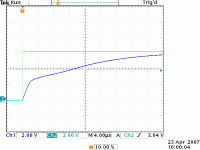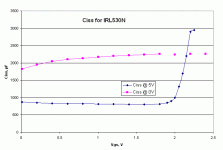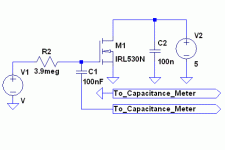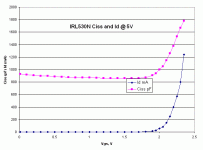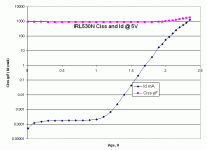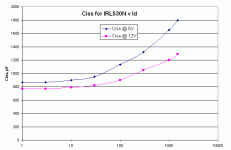Some while ago I did a few interesting measurements on the input capacitance of a couple of different MOSFETs as a function of Vgs. Following a discussion of the matter in another thread
http://www.diyaudio.com/forums/showthread.php?postid=1190954#post1190954
I post here my measurements results and copy some of my comments I've made in that thread.
What I did was to measure the Cgs capacitance with a capacitance meter (1MHz 10mV max) sweeping the Vgs from 0 to Vth and above, leaving the drain connected to the source through a resistor (Vsd=0, Id=0) . Tomorrow I will show my data for a small VMOS from Zetex ZVH0545A and a logic-level power VMOS IRL530N. I've found that the static gate capacitance measured this way is indeed increases over the threshold region by 2 to 3 times for a very small increase in Vgs.
Apparently this change has a very simple explanation - when the channel of the MOSFET is off, the area of the channel itself under the gate is essentially isolated and Cgs+Cgd consists only from a capacitance between the gate and the metallised source/drain connections. When Vgs reaches the threshold level the channel begins to conduct and the area beneath the gate connects to the circuit, markedly (2 to 5 times) increasing the input capacitance even without the Miller effect - in fact even in the abcence of any drain current! If you put some voltage on the drain it somewhat changes the shape of the curve, but not the character of it.
As you can imagine in an audio amplifier there are many cases where the Miller effect is not really present - i.e. in a common drain follower configuration of the O/P stage. However in a class AB amplifier the Vgs of the output devices goes through the threshold region and that kind of a change in the input capacitance of a MOSFET could be quite significant in understanding of unlinearities in such a stage, especially at high frequencies.
Cheers
Alex
First picture is for ZVN0545A @ Vds=0
http://www.diyaudio.com/forums/showthread.php?postid=1190954#post1190954
I post here my measurements results and copy some of my comments I've made in that thread.
What I did was to measure the Cgs capacitance with a capacitance meter (1MHz 10mV max) sweeping the Vgs from 0 to Vth and above, leaving the drain connected to the source through a resistor (Vsd=0, Id=0) . Tomorrow I will show my data for a small VMOS from Zetex ZVH0545A and a logic-level power VMOS IRL530N. I've found that the static gate capacitance measured this way is indeed increases over the threshold region by 2 to 3 times for a very small increase in Vgs.
Apparently this change has a very simple explanation - when the channel of the MOSFET is off, the area of the channel itself under the gate is essentially isolated and Cgs+Cgd consists only from a capacitance between the gate and the metallised source/drain connections. When Vgs reaches the threshold level the channel begins to conduct and the area beneath the gate connects to the circuit, markedly (2 to 5 times) increasing the input capacitance even without the Miller effect - in fact even in the abcence of any drain current! If you put some voltage on the drain it somewhat changes the shape of the curve, but not the character of it.
As you can imagine in an audio amplifier there are many cases where the Miller effect is not really present - i.e. in a common drain follower configuration of the O/P stage. However in a class AB amplifier the Vgs of the output devices goes through the threshold region and that kind of a change in the input capacitance of a MOSFET could be quite significant in understanding of unlinearities in such a stage, especially at high frequencies.
Cheers
Alex
First picture is for ZVN0545A @ Vds=0
Attachments
richie00boy said:Good work, but if you are applying a voltage across gate-source, how can you be sure that driving equipment is not affecting the measured capacitance which is also across gate-source?
Here is the schematics for my setup for 0V Vds:
Cheers
Alex
Attachments
anli said:Alex,
London city is too far to throw an IRFP140N which is in my handHave you power IRFs?
Unfortunately, no. I may order few just for fun but it would not be very soon. I do have a number of other MOSFETs but all these are small to medium power and not IRF
Alex
P.S. However I think that this kind of the input capacitance behaviour is likely to be generic for all MOSFETs.
Curiosity got hold of me over the lunch time and I've decided to get some more information about this effect. And what an interesting session it was. First - it looks like this effect in a power VMOS transistor (I've tortured the same IRL530N) is effectively reduced by a cascoded internal JFET as soon as the drain connected to a voltage source, even if it is 0V, i.e. if I connect the source and the drain directly and not through a high-Ohm resistor, I can barely see the capacitance increase at the threshold thought the overall input capacitance is considerably larger and approximates the final capacitance I've measured after Vth in my previous session. This time I've connected IRL530 to a proper high current power supply that could supply up to a couple of amps of the drain current. I've used a different setup so I could see the result instantly and do it in a pulse and not in a static situation.
The picture with a small MOSFET ZVN0545A on the other hand confirmed my previous measuments for Vds=5V quite accurately, thought the method was different, which is a good indication of a correct result. I attach here a screenshot from a scope. Ch1 shows the voltage on the gate, Ch2 shows the voltage from the pulse generator. Between the generator and the gate there is 100K resistor. Vds=5V DC and decoupled by 100nF. My current thought is that a small MOSFET has a different structure and behaves differently. From the curve for lateral MOSFET 2SJ162 in my earler post it looks like lateral devices do suffer from this effect much more than power VFETs and that small MOSFETs are similar to them. I'll try to get some more samples of different FETs and see how these measure.
Cheers
Alex
The picture with a small MOSFET ZVN0545A on the other hand confirmed my previous measuments for Vds=5V quite accurately, thought the method was different, which is a good indication of a correct result. I attach here a screenshot from a scope. Ch1 shows the voltage on the gate, Ch2 shows the voltage from the pulse generator. Between the generator and the gate there is 100K resistor. Vds=5V DC and decoupled by 100nF. My current thought is that a small MOSFET has a different structure and behaves differently. From the curve for lateral MOSFET 2SJ162 in my earler post it looks like lateral devices do suffer from this effect much more than power VFETs and that small MOSFETs are similar to them. I'll try to get some more samples of different FETs and see how these measure.
Cheers
Alex
Attachments
jackinnj said:International Rectifier has an application note AN-957 "Measuring HexFet Characteristics" which you should take a look at -- you don't need a Tek 576 to do this.
I've read it, however as usual it only describes how to measure the capacitance at Vgs=0.
Alex
More info
Continue measurements and, unfortunately, my previous observation about VFETs are incorrect. After a proper setup was made I've measured Ciss (input capacitance) for IRL530N properly for Vds=0V and Vds=5V, on top of it I've repeted my pulsed experiment for this transistor for different drain voltages (from 0 to 4V) and it appears that the "jump effect" is present in force. Here is the scope trace at Vds=3V similar to the previous for ZVN, however in this case the series resistor was 3.9K to compensate for a higher input capacitance. Note, that the trace is for a constant Vds unlike the traces usually found in the gate charge graphs, where Vd changes and Miller effect is present.
Alex
Continue measurements and, unfortunately, my previous observation about VFETs are incorrect. After a proper setup was made I've measured Ciss (input capacitance) for IRL530N properly for Vds=0V and Vds=5V, on top of it I've repeted my pulsed experiment for this transistor for different drain voltages (from 0 to 4V) and it appears that the "jump effect" is present in force. Here is the scope trace at Vds=3V similar to the previous for ZVN, however in this case the series resistor was 3.9K to compensate for a higher input capacitance. Note, that the trace is for a constant Vds unlike the traces usually found in the gate charge graphs, where Vd changes and Miller effect is present.
Alex
Attachments
Re: More info
Nice work Nikitin.
If you also plot the graph with varying VDS...it would be helpful since amplifiers were used to amplify the signals, hence change of Vds across the device is for sure.....
BTW: Perform your test on Mosfets like IRFP250, because the results would differ much with these because of their higher Ciss and higher VGS threshold....[3-4V]
x-pro said:Note, that the trace is for a constant Vds unlike the traces usually found in the gate charge graphs, where Vd changes and Miller effect is present.
Alex
Nice work Nikitin.
If you also plot the graph with varying VDS...it would be helpful since amplifiers were used to amplify the signals, hence change of Vds across the device is for sure.....
BTW: Perform your test on Mosfets like IRFP250, because the results would differ much with these because of their higher Ciss and higher VGS threshold....[3-4V]
Some more results for IRL530N . This time I've decoupled the drain by an additional 4.7uF to reduce possible Miller effect at higher currents where 0.1uF presents an impedance large enough to affect the result. This time I did measure the Id as well as Vgs and Ciss. First picture shows Ciss and Id variation v Vgs for Vds=5V .
Alex
Alex
Attachments
- Status
- This old topic is closed. If you want to reopen this topic, contact a moderator using the "Report Post" button.
- Home
- Amplifiers
- Solid State
- MOSFET input capacitance
